This is a fortnightly newsletter about the New Zealand Net. If you would like to be notified by email when a new edition is published, please contact ZL1NZ.
Browse our Newsletter Archive and List of Net Tips.
Featured key

Ultimate keys had the brand name engraved on top of the lever. Photos: eBay 2000 (left), ZL2WT
David ZL2WT continues his report on the three unlabeled morse keys in the Western Bay Museum, pictured in NZ Net News NR59.
The Ultimate key was made by Radio (1936) Limited, an Auckland company. RJ (Jack) Orbell ZL1AX was the Chief Engineer and a Director of that company, and many of its products, including radio receivers, carried the Ultimate brand name.
The description of the key in the 1942 Lamphouse Catalogue is as follows: “Heavy brass arm and bridge. Fine adjustment of spacing and tension provided. Wooden knob and finger rest flange, ensuring comfortable operation grip. Mounted on wooden base, finished in varnish. Measures 6 ins long, 3 ins wide, 3 ins high (overall). Cat no. PH111, 16 shillings and 9 pence each.”
In the next edition of NZ Net News, David will describe the last of the three “mystery keys” at the Western Bay Museum.
* If you have an interesting key for this feature, please send me a nice clear photo and a few words describing it.
Quick notes
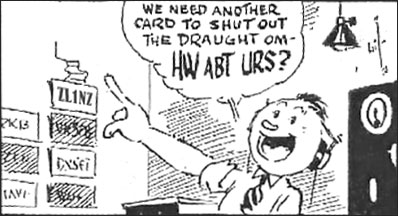 Electronic QSLs can be slow too.
Electronic QSLs can be slow too.
It’s amusing to receive QSL cards via the Bureau and discover that they relate to contacts made many years ago. But a few days ago I received an electronic QSL request, via OQRS, for a contact with Finland in 2014. I think the Bureau might have been faster. 🙂
Radiotelegraph stations KPH, KFS and K6KPH have returned to full operation from the Bolinas, California transmit site and the Point Reyes receive site. This follows an easing of Covid restrictions in the USA, but the stations remain closed to visitors. The Maritime Radio Historical Society, whose volunteers operate the stations, has a new website too.
Ray Burlingame-Goff G4FON has become a Silent Key. Ray was a well-known CW operator, who created the popular G4FON Morse Trainer.
George Boorer ZL3PN died recently in Timaru, age 87. George was not a member of the Net, but was probably known to many NZ amateurs.
The Waitakere Sprint CW Contest is this evening, Saturday 7 August. The Sprint is of one-hour duration on 80m, and is open to amateurs in New Zealand, Australia and Oceania. Best news of all, you don’t need that newfangled computer logging to enter this contest.
Cartoon: Gildersleeve
Net numbers

In July, the NZ Net handled a record number of radiograms (46) and our 212 check-ins almost beat the record of 213 set in June. The number of stations checking in at least once during the month was 15.
Here’s the QNI report for July:
NR69 R ZL1NZ 41/38 AUCKLAND 0900Z 2AUG21 = NZ NET = JULY QNI ZL1AJY 7 ZL1ANY 17 ZL1BWG 15 ZL1NZ 22 ZL2GD 18 ZL2GVA 21 ZL2KE 10 ZL2LN 8 ZL2MS 1 ZL2WT 12 ZL3TK 22 ZL4CU 10 ZL4FZ 3 ZL4KX 17 VK3DRQ 21 VK4PN 8 TOTAL 212 QTC 46 = ZL1NZ
Photo flashback

Mr MR Johnstone of Papatoetoe, a member of the Manukau Radio Club, at one of the control centres of the Amateur Radio Emergency Corps. The control centre is set up in his home. Mr Johnstone is the section leader of the Manukau section of the Amateur Radio Emergency Corps.
South Auckland Courier, 22 April 1964, p34. Auckland Libraries Heritage Collections
Do you recognise the paper tape machine in this photo? If so, I’d appreciate a short article about it for NZ Net News.
Audio interview: Tony 3D2AG
I imagine most CW operators in New Zealand have worked Tony 3D2AG. Operating from Suva, Tony is one of only three active radio amateurs in Fiji. He’s a dedicated CW DXer who can often be found calling CQ near the bottom of 80 or 40 metres with a strong signal. He has even worked NZ on CW on 2 metres!
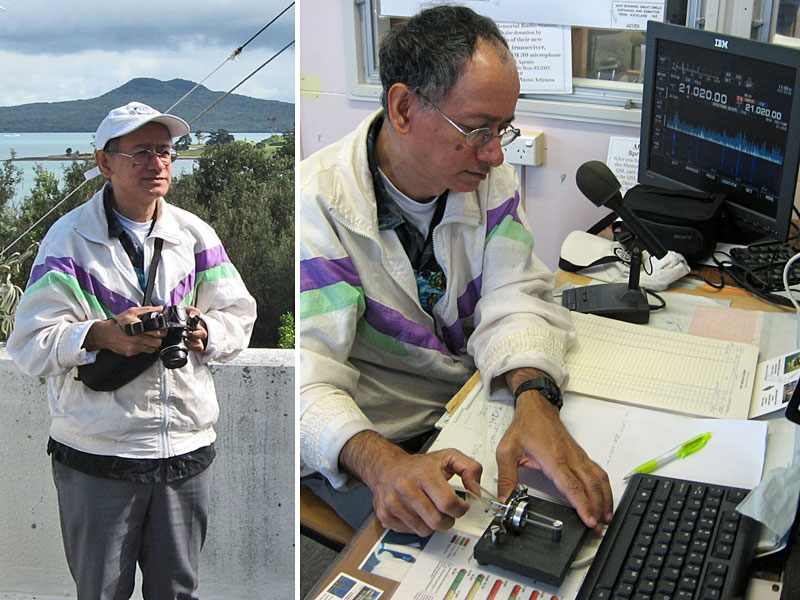
Tony 3D2AG visiting Musick Point Radio Station ZL1ZLD, Auckland, in 2015. Photos: ZL1NZ
In the interview below, Tony talks with Eric 4Z1UG on the QSO Today podcast. He chats about his childhood, academic research and about discovering amateur radio in the 1980s.
RFI: The mysterious case of the drifting buzzer
By Stan ZL3TK
The daily demonstration of RSN reporting by Manny VK3DRQ, based upon the lack of any real need to report modern transmitters’ tone ‘T’, and the advantage of reporting noise ‘N’ as being experienced at the receiving side, is a commendable upgrade to CW operating procedure. I find it jolly useful when relating to the challenges Manny faces in his dense urban environment.
My RSN report to NZ Net control has always been accurate at the time it was sent, usually with an embarrassingly low, and much appreciated noise level. But over the weeks I’ve noticed soon after checking in to the Net, a band of noise, like a buzzer, comes drifting through the IF passband. Sometimes it lands right on top of the Net, or it may drift on past and stop someplace else. It’s annoying, but at N6 and with most ZL signals better than S8, it’s never warranted sending an updated report.
The phenomenon had been going on for several months. Then we began to notice some mornings when we opened the internal door to the garage, that one or both of the garage door-opener lights would be switched on, even though both doors were still down. Strange we thought – no one had been in the garage since the previous evening, and since both remotes were still in the cars, neither could have been accidentally sat upon.
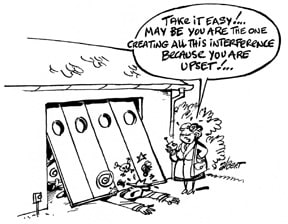 Then one night my XYL arrived home much later than usual. She triggered the garage door exactly 30 seconds before the NZ Net convened. At that same moment, the Drifting Buzzer appeared. Ah-ha! Suddenly we had evidence of one or both LED garage door lights being the source of the noise.
Then one night my XYL arrived home much later than usual. She triggered the garage door exactly 30 seconds before the NZ Net convened. At that same moment, the Drifting Buzzer appeared. Ah-ha! Suddenly we had evidence of one or both LED garage door lights being the source of the noise.
Tests began the next morning and proved that the garage door lights could be switched on and off simply by tapping the Morse key upstairs in the shack, rather like a ‘press and lock’ switch, or a divide by 2 flip-flop. These results proved we had unsuppressed switched-mode LED controllers within the 4W lamps, radiating RF rubbish, most likely into the mains.
Clearly, the RF field radiating from the antenna some 15m distant, through long-run roofing, is strong enough to induce unwelcome currents affecting the CMOS-logic controller chips. Sometime later, my XYL mentioned she had known I was on the air that night because the lights were blinking on and off as she drove into the garage. Depending upon their state at the end of the net, they’d either stay on all night and be noticed in the morning, or be off and everything would seem normal.
We figured the most likely place for RF pick-up was on the five metres of thin-twin wiring between the motor control boxes screwed to the ceiling, and the push-button door switches on the wall, so thought up a simple two-component suppression circuit which was installed and tested. Calculations indicated a suppression factor of 16% at 650 kHz, and 87% at 3.535 MHz.
The filter has proven 100% effective in providing the garage door controllers with immunity to RF interference.
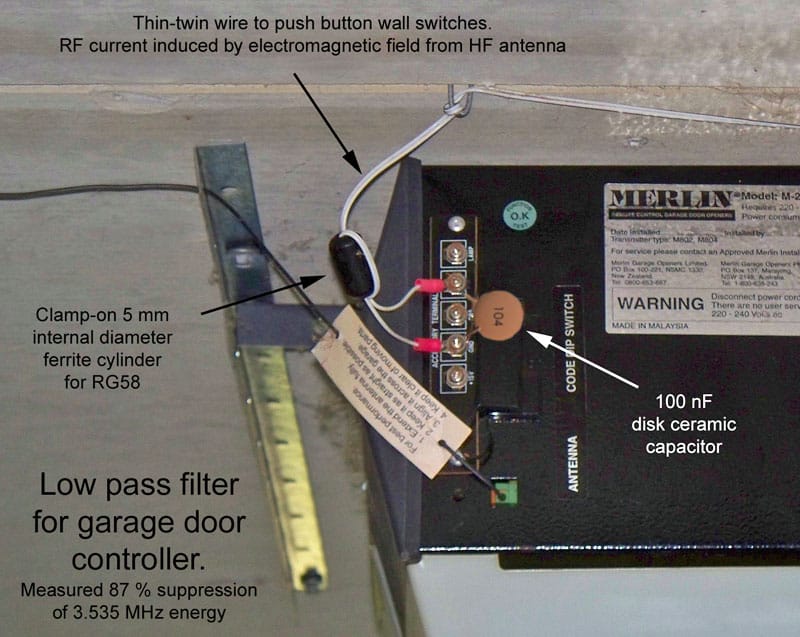
Video: VK4QC on a Marconi 365A key
Peter VK4QC is a retired Radio Officer (ships and Australian coast stations) and maintains a website about coast stations. In this video he is keying a Skanti TRP-8250 into a dummy load using a Marconi 365A key.
If you’d like to work Peter, he is frequently on the VKCW Net, 14349.0 kHz at 0600Z Mon-Fri.
Audio challenge
Our audio challenge in NZ Net News NR60 conveyed the words of Guiglielmo Marconi who was a bit too optimistic about human nature. I received the correct answer from ZL2GVA and ZL3TK.
Audio Challenge is now taking a short break.
NZ Net quiz: What am I?
Can you identify the item on top of the transceiver in this photo and explain why it’s there? I’ll give you a couple of clues after the photo.
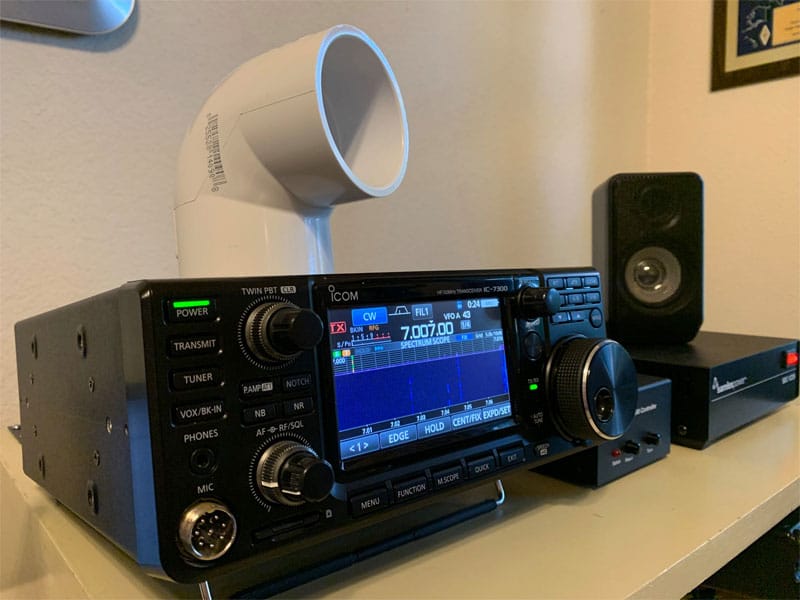
Photo: AA5TB
Clue #1: This accessory can improve the performance of many rigs, not just the IC-7300.
Clue #2: It is not yet available from radio suppliers but, when it is, it is expected to sell for around $499. (Just joking, radio accessories couldn’t be that cheap.)
If you think you know what this item is, and its purpose, let me know via radiogram. There’s a virtual chocolate fish to everyone with the correct answers!
In our previous newsletter, the item with three straight keys on top is a new product, the Triplegraph octave-shifting pedal for use with an electric guitar. If you’d like to see and hear it in action, there are many videos online, including this one (not recommended for people who prefer their music mellow!).
Congratulations to ZL3TK and ZL2GVA who worked it out. Stan told me he was able to track down the logo that appears on the item (I had removed the model name).
Net tip: Double trouble
I think this is kind of funny. While acting as Net Control Station on 28 July, it took me ages to log the first check-in. Why? Everybody tried to check in at the same time!
Finally, Gil ZL4CU “busted the pile-up”. Have a listen, then we’ll talk about what I could have done instead.
I kept thinking that if I just sent <IMI> enough times, people would spread out. But all that did was cue everybody to hit their keys in unison again and again.
It might have gone better if I had just kept silent and waited for someone to seize an opportunity to send their callsign in the clear.
Something else I could have tried would be calling for areas, e.g. ZL1?, ZL2?, etc.
I have learned something from this, and maybe it will help out other Net Control Operators too.
I would also encourage those ops with QSK capability to use it, although it might not have helped a lot in this situation, as people were just sending their sines (not much opportunity to hear between character elements) and the doubling was pretty much perfect!
Advertising archive

73 Magazine, May 1980
Suggestions?
If you have suggestions on how to make the NZ Net better, or things you’d like to see covered in these updates, please contact ZL1NZ. You might even like to write something for the newsletter.
Thanks for reading, and I hope to see you soon on the NZ Net!
—
Neil Sanderson ZL1NZ, Net Manager
New Zealand Net (NZ NET)
3535.0 kHz at 9pm NZT Mon-Fri



